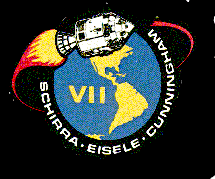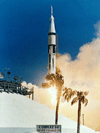|
| |

Apollo 7
 |
(C) |
Walter M. Schirra, Jr. |
Commander |
| (R) |
Donn F. Eisele |
Command Module Pilot |
| (L) |
Walter Cunningham |
Lunar Module Pilot |
Crew Spaceflight Histories
| Walter M. Schirra, Jr. |
| |
Mission |
Dates |
Role |
Notes |
| |
Mercury 8
"Sigma 7" |
October 3,
1962 |
|
5th US citizen
in space. |
|
Gemini VI-A |
December
15-17, 1965 |
Commander |
first space
rendezvous w/ Gemini VII |
| |
Apollo
7 |
October 11-22,
1968 |
Commander |
first manned
test of CSM, Earth orbit |
| |
| Donn F. Eisele |
| |
Mission |
Dates |
Role |
Notes |
| |
Apollo
7 |
October 11-22,
1968 |
Command Module
Pilot |
first manned
test of CSM, Earth orbit |
| |
| R. Walter Cunningham |
| |
Mission |
Dates |
Role |
Notes |
| |
Apollo
7 |
October 11-22,
1968 |
Lunar Module
Pilot |
first manned
test of CSM, Earth orbit |
Apollo 7 Backup Crew:
 Apollo
7 was launched from Cape Kennedy, Fla., at 11:02:45 a.m., EST, on October 11,
1968 from launch complex 34 on top of a Saturn IB. The spacecraft crew consisted
of commander Walter M. Schirra, Jr., command module pilot Donn F. Eisele, and
Walter Cunningham as lunar module pilot. Apollo 7 carried a lunar module pilot,
but no lunar module. Apollo
7 was launched from Cape Kennedy, Fla., at 11:02:45 a.m., EST, on October 11,
1968 from launch complex 34 on top of a Saturn IB. The spacecraft crew consisted
of commander Walter M. Schirra, Jr., command module pilot Donn F. Eisele, and
Walter Cunningham as lunar module pilot. Apollo 7 carried a lunar module pilot,
but no lunar module.
Apollo 7 spent more time in space
than all the Soviet space flights combined up to that time. The mission featured
the first live TV from a manned spacecraft.
 Hot
meals and relatively complete freedom of motion in the spacecraft enhanced crew
comfort over previous Mercury and Gemini flights. The service module service
propulsion system (SPS) main engine proved itself by accomplishing the longest
and shortest manned SPS burns and the largest number of inflight restarts. The
SPS engine was the largest thrust engine to be manually thrust
vector-controlled. Hot
meals and relatively complete freedom of motion in the spacecraft enhanced crew
comfort over previous Mercury and Gemini flights. The service module service
propulsion system (SPS) main engine proved itself by accomplishing the longest
and shortest manned SPS burns and the largest number of inflight restarts. The
SPS engine was the largest thrust engine to be manually thrust
vector-controlled.
As part of the effort to
alleviate fire hazard prior to liftoff and during initial flight, the command
module cabin atmosphere was composed of 60% oxygen and 40% nitrogen. During this
period the crew was isolated from the cabin by the suit circuit, which contained
100% oxygen. Shortly after liftoff, the cabin atmosphere was gradually enriched
to pure oxygen at a pressure of 5 pounds per square inch.
Some significant spacecraft
changes from Block I included the addition of a fire extinguisher and emergency
oxygen masks, an onboard TV camera, and S-band equipment.
| Launch: |
October 11, 1968
16:02:45 UT
Kennedy Space Center Launch Complex 34 (Saturn 1B) |
| Lunar Module: |
not flown |
| Command and Service
Module: |
Apollo Seven
|
| Mission Duration: |
260 hours 9 minutes
3 seconds |
| Altitude: |
140 x 183 miles |
| Orbits: |
163 |
| Returned to Earth: |
October 22, 1968
splashdown 11:11:48 UT (7:11:48 a.m. EDT) |
| Retrieval site: |
Atlantic Ocean 27°
32' N, 64° 04' W |
| Retrieval ship: |
U.S.S. Essex |
|
Highlights/Notes:
- First U.S. three man mission
- First flight of Block II Apollo Spacecraft.
- First flight of the Apollo space suits.
- First flight with full crew support
equipment.
- First live national TV from space during a
manned space flight.
|
|
